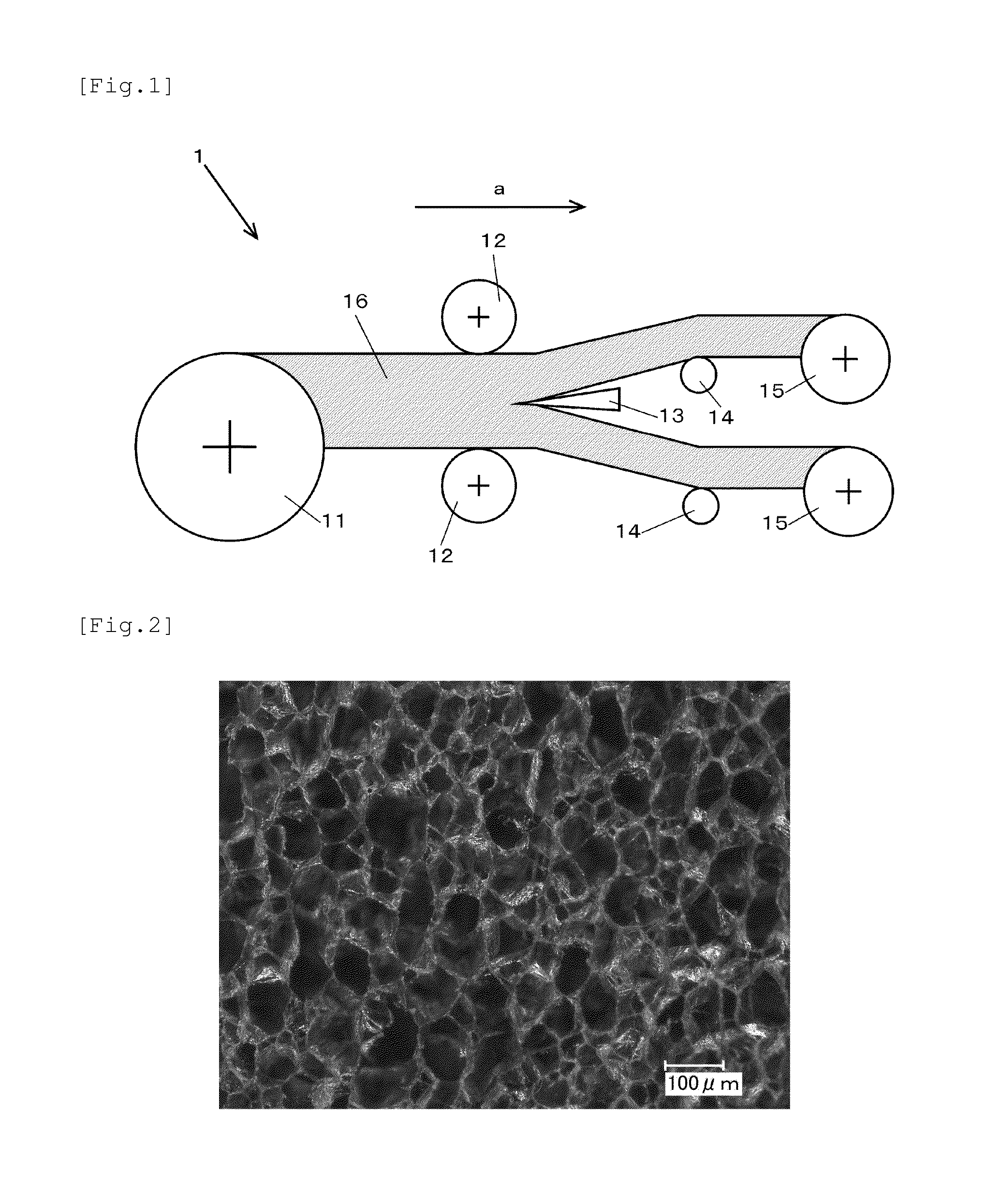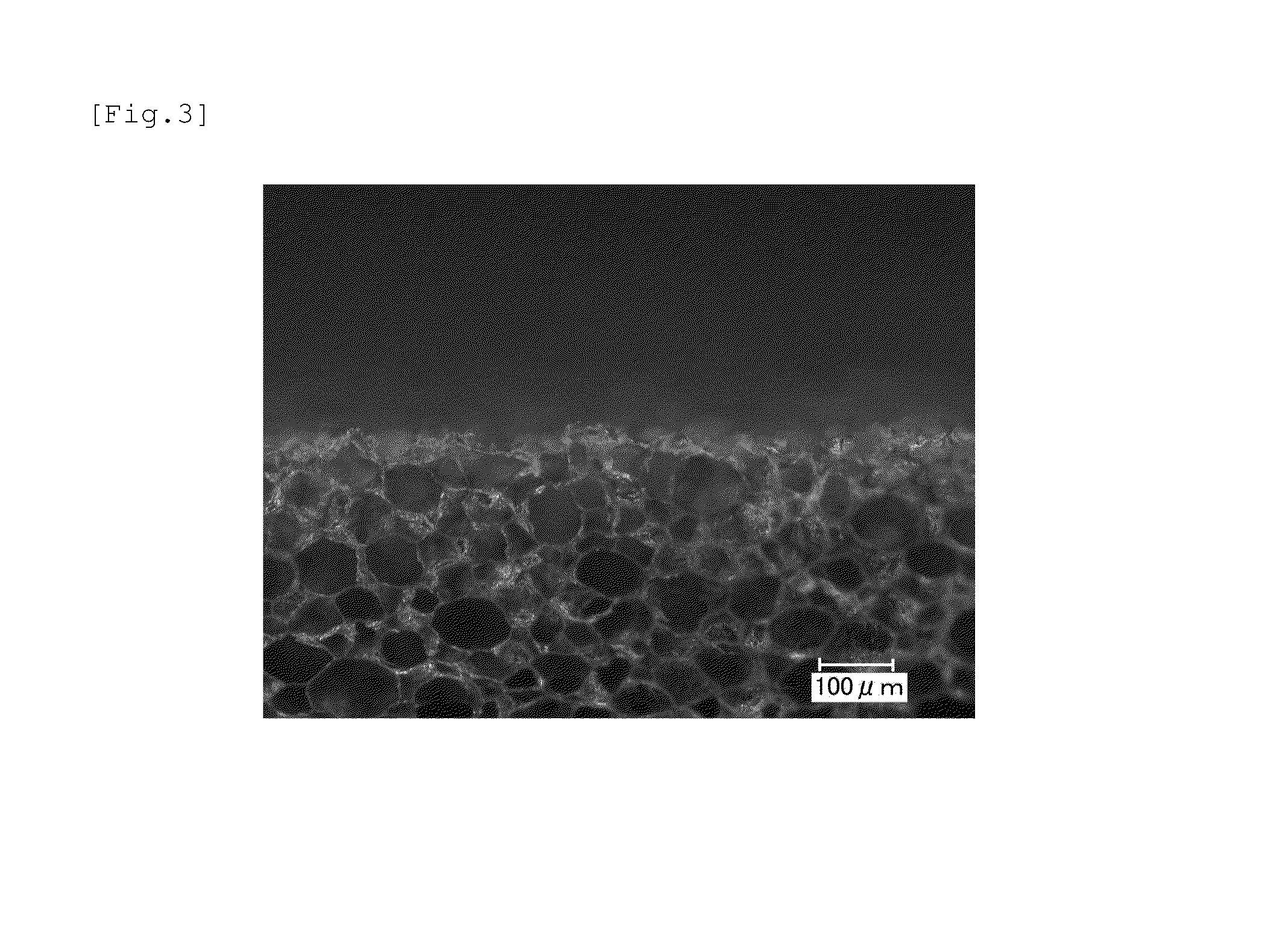Resin foam sheet and resin foam member
a technology of resin foam and resin foam, which is applied in the direction of film/foil adhesives, layered products, transportation and packaging, etc., can solve the problems of low surface skin expansion, disadvantageous poor flexibility, and inferior bump conformability, and achieve satisfactory stab wounding, low apparent density, and thin and flexible
- Summary
- Abstract
- Description
- Claims
- Application Information
AI Technical Summary
Benefits of technology
Problems solved by technology
Method used
Image
Examples
example 1
[0128]In a twin-screw kneader (The Japan Steel Works, LTD. (JSW)) at a temperature of 200° C. were kneaded 45 parts by weight of a polypropylene [trade name “EA9,” Japan Polypropylene Corporation, melt flow rate (MFR): 0.5 g / 10 min], 45 parts by weight of a mixture [melt flow rate (MFR): 6 g / 10 min, JIS-A hardness: 79°] including a polyolefinic elastomer and a softener, 10 parts by weight of magnesium hydroxide, 10 parts by weight of carbon (trade name “Asahi #35,” Asahi Carbon Co., Ltd.), and 1.5 parts by weight of stearic monoglyceride. The kneadate was extruded into strands, cooled with water, and formed into pellets. The pellets were charged into a single-screw extruder (The Japan Steel Works, LTD.), into which carbon dioxide gas was injected at an ambient temperature of 220° C. and a pressure of 19 MPa, where the pressure became 16 MPa after injection. The carbon dioxide gas was injected in an amount of 5.9 percent by weight relative to the total amount of the pellets. After be...
example 2
[0131]In a twin-screw kneader (The Japan Steel Works, LTD. (JSW)) at a temperature of 200° C. were kneaded 40 parts by weight of a polypropylene [trade name “EA9,” Japan Polypropylene Corporation, melt flow rate (MFR): 0.5 g / 10 min], 55 parts by weight of a mixture [melt flow rate (MFR): 2 g / 10 min, JIS-A hardness: 69°] including a dynamically-cross-linked polyolefinic elastomer and a softener, 10 parts by weight of magnesium hydroxide, 10 parts by weight of carbon (trade name “Asahi #35,” Asahi Carbon Co., Ltd.), and 0.8 part by weight of stearic monoglyceride. The kneadate was extruded into strands, cooled with water, and formed into pellets. The pellets were charged into a single-screw extruder (The Japan Steel Works, LTD.), into which carbon dioxide gas was injected at an ambient temperature of 220° C. and a pressure of 19 MPa, where the pressure became 16 MPa after injection. The carbon dioxide gas was injected in an amount of 4.8 percent by weight relative to the total amount ...
example 3
[0134]In a twin-screw kneader (The Japan Steel Works, LTD. (JSW)) at a temperature of 200° C. were kneaded 40 parts by weight of a polypropylene [trade name “EA9,” Japan Polypropylene Corporation, melt flow rate (MFR): 0.5 g / 10 min], 40 parts by weight of a mixture [melt flow rate (MFR): 2 g / 10 min, JIS-A hardness: 69°] including a dynamically-cross-linked polyolefinic elastomer and a softener, 10 parts by weight of magnesium hydroxide, 10 parts by weight of carbon (trade name “Asahi #35,” Asahi Carbon Co., Ltd.), and 1.5 parts by weight of stearic monoglyceride. The kneadate was extruded into strands, cooled with water, and formed into pellets. The pellets were charged into a single-screw extruder (The Japan Steel Works, LTD.), into which carbon dioxide gas was injected at an ambient temperature of 220° C. and a pressure of 19 MPa, where the pressure became 16 MPa after injection. The carbon dioxide gas was injected in an amount of 4.6 percent by weight relative to the total amount...
PUM
| Property | Measurement | Unit |
|---|---|---|
| width | aaaaa | aaaaa |
| length | aaaaa | aaaaa |
| thickness | aaaaa | aaaaa |
Abstract
Description
Claims
Application Information
 Login to View More
Login to View More - R&D
- Intellectual Property
- Life Sciences
- Materials
- Tech Scout
- Unparalleled Data Quality
- Higher Quality Content
- 60% Fewer Hallucinations
Browse by: Latest US Patents, China's latest patents, Technical Efficacy Thesaurus, Application Domain, Technology Topic, Popular Technical Reports.
© 2025 PatSnap. All rights reserved.Legal|Privacy policy|Modern Slavery Act Transparency Statement|Sitemap|About US| Contact US: help@patsnap.com



